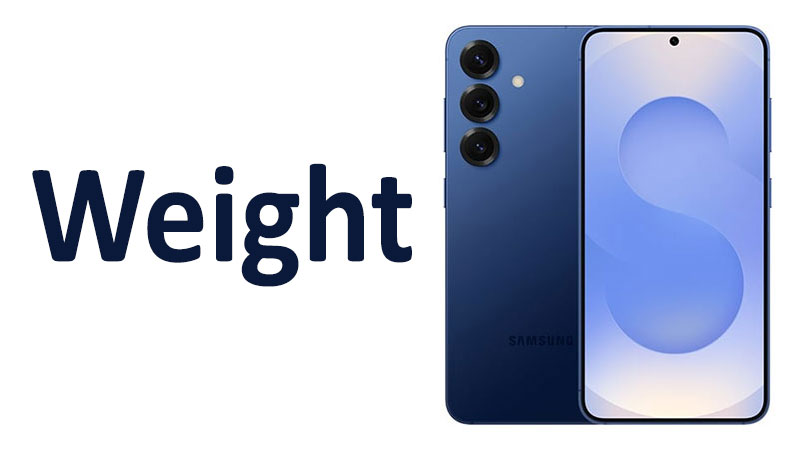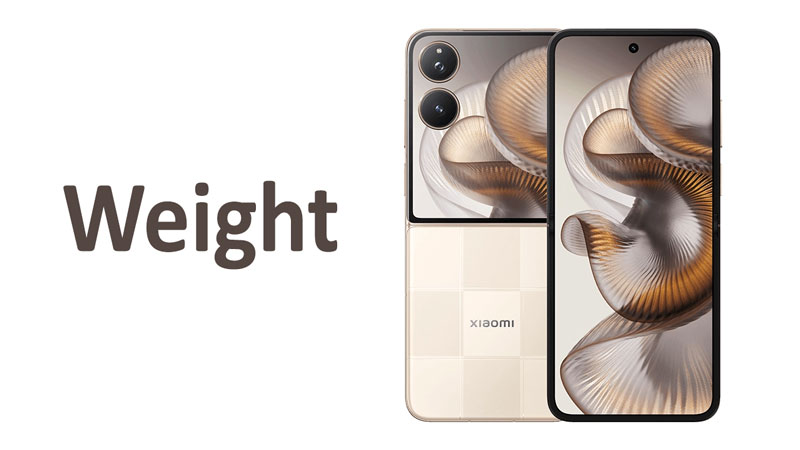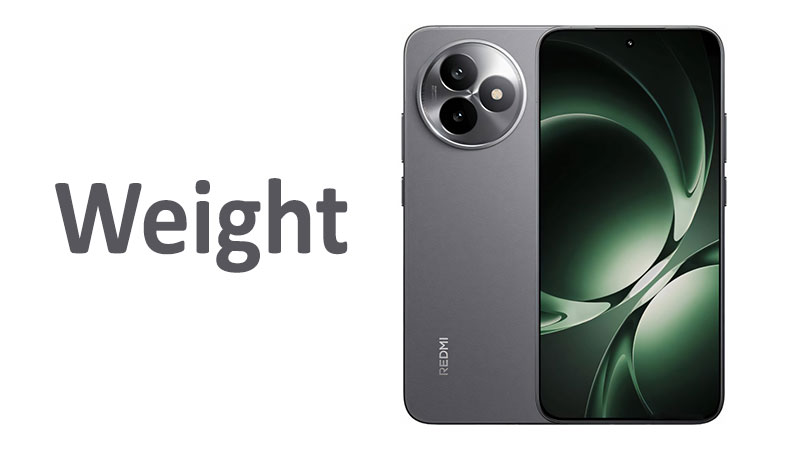The Samsung Galaxy S25 weight is a critical specification for modern smartphone users. This seemingly small detail significantly impacts daily use and portability. Understanding the exact mass of this flagship device is essential for potential buyers. The weight dictates how the phone feels in your hand over extended periods. It also affects how comfortably the device sits in your pocket or bag. This comprehensive analysis breaks down the S25’s mass in both metric and imperial units. We will thoroughly examine the engineering, compare it to key competitors, and discuss the ergonomic implications. Ultimately, this information will guide your purchasing decision.
The Weight Specifications: Grams and Ounces
The precise mass of the standard Samsung Galaxy S25 model is a highlight of its design. It confirms Samsung’s commitment to lightweight flagship portability. The official weight is 162 grams.
The Numerical Breakdown
The Samsung Galaxy S25 weighs exactly 162g. This is a highly optimized measurement for a powerful modern device. For users accustomed to imperial units, this converts to 5.71 ounces. These two figures are crucial for understanding the phone’s physical presence.
The measurement of 162g positions the S25 firmly in the lightweight category. This weight class offers superior handling and reduced physical fatigue. Consequently, the phone is easier to use during long streaming sessions. It is also more comfortable during extended phone calls.
Significance of the 162-Gram Mark
Reaching 162g requires exceptional engineering and component selection. Every internal part must be carefully considered for its contribution to the total mass. The 162g figure is a testament to Samsung’s material science advancements. It proves that high performance does not require excessive bulk.
The goal is to maintain a premium feel despite the lightness. A well-balanced device feels solid, even at a low mass. Therefore, the 162g S25 still offers a reassuring quality when you hold it.
The Importance of 5.71 Ounces
The imperial weight of 5.71 oz is more relevant to users in specific markets. Many consumers visualize ounces more easily than grams for small personal items. A weight of 5.71 ounces is notably light for a large-screen smartphone. This compares favorably against many competitors in the same category.
For instance, devices that exceed seven or eight ounces can feel heavy quickly. The 5.71 oz mass of the S25 avoids this common issue. Furthermore, this low figure simplifies portability significantly. It prevents the phone from dragging down clothing pockets.
Specialized Comparisons: Previous Samsung Generations
The weight evolution of the standard Galaxy S series reveals an interesting design philosophy. Samsung consistently attempts to find the perfect balance between power and portability. The Galaxy S25 weight of 162g fits into this pattern.
Samsung Galaxy S25 vs. Galaxy S24 Weight
The previous generation, the Galaxy S24, had a very similar, highly optimized mass. Assuming a stable design, the S25 retains this featherlight approach. Small fluctuations, perhaps one or two grams, might occur due to component upgrades. For example, a slightly larger camera sensor or a refined cooling system could add minimal mass.
However, the core goal remains the same: staying close to that sweet spot of 162g. Maintaining this low weight ensures a consistent user experience year over year. Therefore, users upgrading from the S24 will feel an immediate familiarity.
Samsung Galaxy S25 vs. Galaxy S23 Weight
The Galaxy S23 also prioritized a compact and lightweight design. Moving from the S23 to the S25, the user experiences a continuation of this lightweight lineage. Samsung has perfected the use of refined materials to achieve this.
They utilize advanced aluminum alloys for the frame. They also use specialized lightweight protective glass for the front and back panels. These material choices contribute directly to the 162g mass. Consequently, the S25 continues the tradition of slim, pocket-friendly flagship devices.
The Ultra Model Contrast
It is essential to differentiate the standard S25 from the S25 Ultra model. The Ultra model includes a larger screen and a massive battery. It also features a built-in S Pen stylus and a more complex camera array. Therefore, the S25 Ultra is considerably heavier than the 162g standard model.
The weight difference is often substantial, easily exceeding 230g (over 8 oz). This contrast highlights the S25’s appeal. It offers a powerful flagship experience without the excessive mass of an Ultra device. Many users prefer the portability of the lighter 162g phone.
Specialized Comparisons: Key Competitors
Comparing the Samsung Galaxy S25 weight to its direct competitors highlights its competitive advantage. The 162g measurement is often a winning factor for Samsung.
S25 vs. Standard iPhone Model Weight
The closest competitor is often the standard flagship iPhone model. iPhones typically use stainless steel frames, which are inherently denser than aluminum. As a result, the standard iPhone model often weighs more than the 162g S25. This difference can easily be 10 to 15 grams or more.
This extra mass is often immediately noticeable in hand. Therefore, the S25 feels significantly lighter and easier to handle. Buyers prioritizing a lightweight feel gain a clear benefit from the S25’s design. This is a major selling point for the S25 platform.
S25 vs. Google Pixel Standard Model Weight
Google’s flagship Pixel phones also compete in this premium category. Pixel devices generally occupy a similar weight range to the S25. However, they sometimes feature thicker or denser chassis designs. The S25’s 162g target remains exceptionally competitive against the Pixel.
The perceived weight is also affected by the device’s balance. Even if the numbers are close, the S25 often feels better distributed. This superior balance makes the 162g device feel even lighter during active use.
The Lightweight Flagship Category
The 162g mass places the S25 in a distinct “lightweight flagship” category. Many high-end phones are trending toward heavier designs. They prioritize features like massive batteries or robust materials. Meanwhile, the S25 holds the line on portability.
This strategy appeals to users who value convenience above all else. Consequently, the S25 serves a specific, important segment of the market. It represents the pinnacle of compact, powerful smartphone design.
The Engineering Behind the 162g Weight
Achieving a weight of 162g while maintaining performance is a significant engineering feat. It is not an accident; it is a result of meticulous design choices.
Advanced Material Choices
The primary factor is the judicious use of advanced materials. Samsung relies on its proprietary Armor Aluminum for the frame. This material offers high durability at a fraction of the weight of stainless steel. This choice saves critical grams from the chassis itself.
Furthermore, the glass panels use refined manufacturing techniques. They reduce thickness and density without compromising scratch resistance. Every component, from the display adhesive to the internal cabling, is weight-optimized. This cumulative effort leads to the final 162g weight.
Internal Component Optimization
The internal layout of the S25 is extremely dense and efficient. Samsung utilizes advanced packaging techniques to minimize empty space. Components like the processor and memory are layered tightly together. This saves the mass that extra spacing would require.
The use of a highly efficient processor is also important. The latest chipsets require less massive cooling systems. A smaller, lighter vapor chamber or graphite sheet can effectively manage heat. This weight reduction in cooling hardware contributes to the 162g total.
Battery Size and Weight Trade-offs
A lower weight sometimes implies a smaller battery. However, the S25 aims for maximum power efficiency to offset this. The 162g S25 likely maintains a substantial battery. Samsung optimizes the battery chemistry for high energy density. This allows them to use a physically lighter battery that still provides excellent longevity.
The overall efficiency of the software and processor also extends battery life. Therefore, the 162g weight does not necessarily mean poor endurance. Buyers get both the convenience of lightness and reliable all-day power.
Ergonomics and Usability of 162g
The 162g weight is more than just a number. It defines the daily ergonomic experience of the phone. This light weight contributes significantly to user comfort.
Enhanced One-Handed Operation
The low mass improves one-handed use dramatically. It is easier to shift your grip without the phone feeling top-heavy or unstable. This is crucial for quick checks and navigating while on the move. The 162g weight reduces the strain on your thumb and wrist muscles.
It makes the phone feel more manageable, especially for users with smaller hands. Consequently, the S25 is less likely to slip out of a loose grip. The light weight contributes to improved confidence when handling the device.
Reduction in Fatigue for Extended Use
Using any device for hours can lead to hand and wrist fatigue. This is especially true when streaming videos or reading long articles. The 162g Samsung Galaxy S25 weight significantly reduces this strain. Your hand muscles do not have to work as hard to support the device.
This reduction in fatigue is a major benefit for power users. It enhances the long-term enjoyment of the smartphone. Moreover, it makes the S25 an excellent choice for mobile gaming enthusiasts.
Minimal Pocket Impact
A phone weighing 162g is barely noticeable in most clothing pockets. Heavier phones can cause pockets to sag unattractively. They can also create discomfort when walking or sitting. The lightweight S25 mitigates these common issues.
Its portability extends beyond simply fitting into a pocket. It also concerns the comfort of carrying it throughout a busy day. The 5.71 oz mass makes the S25 feel almost non-existent when stored. This is a massive advantage for daily commuters and travelers.
Pros and Cons of the 162g Weight
The highly optimized 162g weight carries a distinct set of advantages and disadvantages. Evaluating these points helps the buyer make an informed decision.
Pros of Being Lightweight
The most significant benefit is the unparalleled portability. The S25 slips easily into any space without feeling cumbersome. Furthermore, the light mass improves overall handling and reduces accidental drops. A lighter phone is easier to catch or stabilize during a fumble.
The 162g weight makes the phone feel fast and responsive in your hand. This psychological effect enhances the user interface experience. Overall, lightness is synonymous with modern, refined technology.
Cons and Potential Trade-offs
One potential drawback is the psychological perception of quality. Some consumers equate heavy weight with premium construction. The 162g S25 might initially feel too light to some users. They might worry about the durability of the materials.
However, advanced materials like Armor Aluminum contradict this perception. Another potential trade-off concerns the battery. While Samsung optimizes for efficiency, a heavier phone could accommodate an even larger battery cell. Buyers must decide if portability outweighs absolute battery capacity.
Buyer Considerations and Key Takeaways
Consumers considering the Samsung Galaxy S25 must weigh the 162g specification against their personal needs. This weight profile is ideal for a specific type of user.
Ideal User Profile for 162g
The S25 is perfect for users who prioritize active use and minimalist carrying. This includes runners, cyclists, and fitness enthusiasts. The light mass is less disruptive during physical activity. It is also suitable for business professionals who carry many items. A lighter phone reduces overall daily burden.
Users upgrading from older, heavier phones will especially appreciate the 162g design. The reduced strain on their hands will be a refreshing change. They gain significant ergonomic value for their investment.
The Perception of Durability
The low 162g weight does not compromise the phone’s structural integrity. Samsung uses strong, impact-resistant materials despite the lightness. The frame is tough, and the glass is highly resilient. Therefore, the light feel is not an indicator of fragility.
Buyers should focus on the quality of the materials, not just the mass. The S25 maintains a high standard of construction. Its durability is in line with other premium flagship devices.
Impact of Cases on Weight
It is important to remember that a protective case will add mass. A heavy-duty, rugged case can easily add 50 to 80 grams. This increase would push the total weight of the S25 past 200g (over 7 oz). This negates the advantage of the 162g base weight.
Buyers should select a slim, lightweight case to preserve the phone’s feel. Choosing a minimal case helps keep the total carried weight low. This ensures the 162g optimization remains beneficial for daily use.
Conclusion
The Samsung Galaxy S25 weight, at a highly refined 162g (5.71 oz), is a defining feature. It positions the standard S25 as a benchmark for lightweight flagship design. This optimized mass provides significant ergonomic benefits. It makes the phone easier to handle, reduces fatigue, and enhances portability.
Through clever engineering and material selection, Samsung achieves this lightness. They do this without sacrificing crucial features like screen size or performance. The 162g weight represents a conscious choice for superior user comfort. Choose the S25 if you desire a powerful device that is comfortable and easy to carry. This phone offers the perfect compromise between a feature-rich experience and ultimate portability. The S25 delivers flagship power without the burdensome mass.
Frequently Asked Questions (FAQ)
Is 162g considered heavy for a modern smartphone?
No, 162g (5.71 oz) is considered exceptionally light for a flagship smartphone. Many comparable models exceed 175g.
Does the low weight of 162g mean the phone has a small battery?
The 162g weight suggests an optimized battery size. However, Samsung’s high power efficiency ensures reliable all-day battery life.
How does the S25 weight compare to the S25 Ultra?
The standard S25 weighs 162g, making it significantly lighter than the S25 Ultra. The Ultra model often weighs over 230g.
Will adding a case ruin the light feel of the 162g phone?
A thick case will add substantial mass. A slim, lightweight case is recommended to maintain the comfortable 162g feel of the device.
What material helps keep the S25 at a lightweight 162g?
Samsung primarily uses an advanced Armor Aluminum alloy for the frame. This material is both strong and much lighter than stainless steel.



